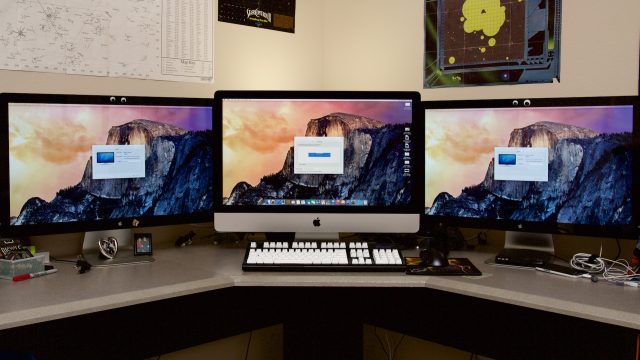
A year ago Apple introduced a new Retina 5K iMac at the high end of the lineup and left everything else alone. This year, the entire lineup is getting a refresh—not only is there a new 4K model of the 21.5-inch iMac, but all of the 27-inch non-Retina iMacs are being replaced by 5K Retina models. The 27-inch models are also getting some nice internal upgrades, including quad-core Intel Skylake CPUs, new dedicated AMD Radeon GPUs, and faster PCI Express SSDs and Fusion Drive configurations.
The new 5K iMacs start at $1,799, the same starting price as the previous-generation, non-Retina iMac—that model comes with a quad-core 3.2GHz (3.6GHz Turbo) Core i5-6500, 8GB of 1867MHz DDR3 RAM, a 1TB 7200 RPM hard drive, and an AMD Radeon R9 M380 with 2GB of GDDR5 memory. All of the new 27-inch iMacs also include Apple's redesigned Magic Keyboard and your choice of either a Magic Mouse 2 (included) or Magic Trackpad 2 ($50 extra).
The $1,999 configuration uses the same CPU and the same 8GB of RAM, but it bumps the GPU to an AMD Radeon R9 M390 with 2GB of GDDR5 and upgrades you to a 1TB Fusion Drive. And the $2,299 model gets you 8GB of RAM with a 3.3GHz (3.9GHz Turbo) Core i5-6600, a Radeon R9 M395 with 2GB of GDDR5, and a 2TB Fusion Drive.
All of the new 27-inch iMacs use a 5120×2880 screen with a 217 PPI resolution, but these panels are subtly better than the ones in past 5K iMacs. They support the wider DCI-P3 color gamut commonly used in digital movie theaters, an upgrade that gives you a wider range of reds and greens than were visible on previous-generation sRGB displays. It's not an upgrade that's going to make any current 5K iMacs obsolete, but, if you've been holding off on buying one, it's a nice reward for your patience.
Upgrade options and new storage configurations
As usual, Apple will let you upgrade most of the components in these base iMac models to suit your needs. All three 5K iMac configurations can be upgraded to an AMD Radeon R9 M395X GPU with 4GB of GDDR5, and the top two configurations can add a 4.0GHz (4.2GHz Turbo) Core i7-6700K. This CPU adds Hyper-threading along with the additional clock speed.
All three iMac models can be configured with 16GB or 32GB of 1867MHz DDR3 (not DDR4) RAM from the factory. Since the 27-inch iMacs' four RAM slots are still hidden under an easily accessible hatch, it's generally going to be cheaper to buy your own memory and install it yourself—the default configuration leaves two RAM slots free for easy upgrades without throwing out the memory that's already included. Skylake CPUs should theoretically support a maximum of 64GB of RAM if you use 16GB DIMMs, but it doesn't appear to be officially supported, and such high-density RAM sticks are both rare and expensive.
All can also be configured with a variety of Fusion Drive and pure SSD storage options, something we'd definitely recommend for any and all iMac purchases (the two higher-end configurations have standard Fusion Drives, but they really should be included across the lineup at this point). The $1,799 iMac can be configured with 1TB, 2TB, or 3TB Fusion Drives, or if you prefer to go all-flash you can get a 256GB or 512GB SSD. The two higher-end models add an option for a 1TB SSD. All solid-state storage in the new iMacs uses the NVMExpress interface that first showed up in the Retina MacBook earlier this year, and like the 13-inch Retina MacBook Pro they all have four PCIe 2.0 lanes' worth of bandwidth to work with, giving them data transfer speeds of up to 2GB per second.
If you're buying a model with a Fusion Drive, know that Apple has slightly tweaked the Fusion Drive configurations in all the new 21.5-inch and 27-inch iMacs. 1TB Fusion Drives in the new Macs pair that 1TB hard drive with 24GB of flash storage rather than the heretofore-standard 128GB; this is enough for the core OS and a few apps, so boot time and most app launches should still feel speedy but you may notice the Mac hitting the hard drive more often than it does with other Fusion Drives. The upside is that it's a cheaper upgrade than Fusion Drives usually are, and it adds just $100 to the price of the iMac. The 2TB and 3TB Fusion Drive options still use a 128GB SSD.
Finally, the new iMacs come standard with a headphone jack, an SD card slot, four USB 3.0 ports, two Thunderbolt 2 ports, a gigabit Ethernet port, 1.3Gbps 802.11ac Wi-Fi, and Bluetooth 4.0. Non-Retina iMacs never got Thunderbolt 2 so this is the first time it's been available across the entire lineup—all of these computers can drive two external 4K displays at 60Hz. You can drive an external 5K display at 60Hz as well, but because the new iMacs don't support DisplayPort 1.3 it requires the use of both Thunderbolt ports.
All of the refreshed 21.5-inch and 27-inch iMac models are available for purchase now. Our full review of the 4K 21.5-inch iMac is available here, and we hope to test drive a souped-up version of the 27-inch iMac in the coming weeks.
reader comments
58